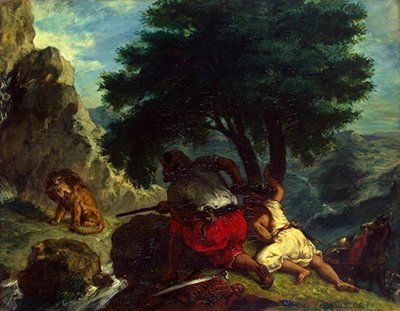Eugene Delacroix would produce a number of animal depictions within his career and the theme of wild nature was an important one within the overall Romanticist movement. He would also complete a number of landscape paintings as well, but these were relatively rare.
He would have studied each creature to appear in his work many times over, and is even known to have sat for hours within a well known Paris zoo in order to admire and learn about tigers and lions from a safe distance. He would also have studied a number of publications as well in order to perfect his understanding and technical depictions of all of these animals. The scene found here in Lion Hunt in Morocco had the added aspect of offering an insight into an exotic culture as well, something that Delacroix loved to do throughout his career. He would take many sketches during his travels abroad, including in Morocco, and would later refer to them when he returned home to the safety and comfort of his own studio. His Orientalist work offers an intriguing strand of work within his overall oevure and has started to receive more interest in recent generations.
The composition features several brave hunters attempting to corner this beautiful creature on a cliff top. Perhaps he has been cornered and has nowhere to go, which likely would have led to either his death or for him to launch a direct attack at the hunters. In the background we see rolling hills, whilst vertically the painting is constructed around the main tree, behind which the hunters carefully hide. Lighting and shadows are carefully used to illustrate this point, with only one portion of both figures being draped in light, whilst the rest of them appear to be much harder for the animal to spot. Assuming the artist was here at the time, it would have been an exciting but frightening experience.
This painting is dated at 1854 and can be found in the impressive collection of the Hermitage Museum in Russia, who have owned it since 1922. Their collection is huge and spread around several buildings, with much more in storage. Their array of Faberge eggs will interest almost anyone, whilst art followers will find highlights such as Arab Saddling his Horse, also by Delacroix, Assumption of the Virgin Mary by Guercino plus Bacchus from Rembrandt. One could spend an entire week, easily, walking around this incredible arrangement of art and antiquities, marking it out as one of the finest art institutions in the world, without any doubt.




